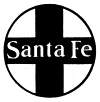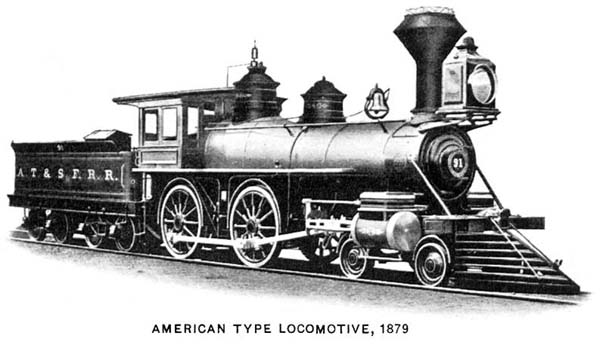|
Philadelphia, Pa., U.S.A. - 1906
Railway System |
|
During the next ten years the system was rapidly extended and additional lines were acquired. In 1895, the mileage operated as the Atchison, Topeka and Santa Fe Railroad was 4582.12; the total mileage in the system including controlled roads, being 9321.29. The company was in the hands of receivers at this time, and a complete reorganization being decided upon, a new charter was secured, under the laws of Kansas, on December 12, 1895. The new corporation took possession of the property on January 1, 1896, under the name of The Atchison, Topeka and Santa Fe Railway Company. Since then additional lines have been acquired by the management. On June 30, 1904, the total mileage embraced in the published results of operations of The Atchison, Topeka and Santa Fe Railway Company was 8300.92; the entire length of the system, including roads controlled or owned jointly with other companies, being 9269.20 Miles. A double daily service is maintained between Chicago and San Francisco, and through sleepers are run between Chicago, Los Angeles and San Diego. The "California Limited," (train No. 3 west bound and train No. 4 east bound), which carries first class passengers only, takes rank as one of the finest trains in the world. The distance from Chicago to San Francisco is 2577 miles, the actual running time for train No. 3 being seventy-six hours fifty-five minutes, representing an average speed, including stops, of thirty-three and five-tenths miles per hour. The road crosses three mountain ranges, where heavy grades are encountered. The history of the motive power of the Santa Fe System is of peculiar interest because, since the advent of the very heavy locomotive, this road has played a leading part in its development. The Baldwin Locomotive Works, has been closely identified with this development, having supplied altogether since the beginning of the road, some 1000 locomotives. These engines have been of various types, and a brief review of the classes represented will prove interesting. The first locomotives constructed at the Baldwin Locomotive Works for the Santa Fe System were four in number. They were built in 1875, and were of the "American type," bearing the road numbers, 44, 45, 46 and 47. These engines were representative of a type generally employed at that time for working all classes of traffic. They had cylinders sixteen inches in diameter by twenty-four inches stroke, the driving wheels being fifty-seven inches in diameter with a wheelbase of eight feet. The total wheelbase was twenty-one feet nine inches. The boiler was of the crown bar wagon top type with iron shell and a steel firebox. It was forty-six inches in diameter and contained 144 tubes, two inches in diameter and ten feet ten and three-eighths inches long. The firebox was sixty-four and three-quarters inches long by thirty-four and one-half inches wide. The grate area was fifteen and seventy-four one hundredths square feet, and the total heating surface 926 square feet. These engines weighed about 67,000 pounds, and carried about 42,000 pounds on their driving wheels. They were furnished with eight-wheel tenders, having wood frames and tanks of 2000 gallons capacity. Four locomotives of similar weights and dimensions were built in 1877 and 1878. During the following year, 1879, thirteen engines of the same type,
but of greater power, were supplied by the Baldwin Locomotive Works,
one of them, |








 The Atchison, Topeka and Santa Fe Railway System
occupies a prominent position among the great railway systems of
the United States. The original company was chartered on February
11, 1859, under the name of the Atchison and Topeka Railroad Company.
This name was changed on March 3, 1863, to Atchison, Topeka and
Santa Fe Railroad Company. The construction of the main line was
begun in 1869, and the road was opened for traffic on February 20,
1873. The original main line extended from Atchison, Kansas, to
the western boundary of the state, and was 470.58 miles in length;
the Company also operating 39.28 miles of branch lines. During the
years 1874 to 1885, additional extensions and branch lines aggregating
1357.90 miles were opened, bringing the total length of main line
and branches, on December 31, 1885, up to 1867.76 miles. The mileage
of controlled roads amounted to 878.99, the total mileage of the
system thus being 2746.75 miles.
The Atchison, Topeka and Santa Fe Railway System
occupies a prominent position among the great railway systems of
the United States. The original company was chartered on February
11, 1859, under the name of the Atchison and Topeka Railroad Company.
This name was changed on March 3, 1863, to Atchison, Topeka and
Santa Fe Railroad Company. The construction of the main line was
begun in 1869, and the road was opened for traffic on February 20,
1873. The original main line extended from Atchison, Kansas, to
the western boundary of the state, and was 470.58 miles in length;
the Company also operating 39.28 miles of branch lines. During the
years 1874 to 1885, additional extensions and branch lines aggregating
1357.90 miles were opened, bringing the total length of main line
and branches, on December 31, 1885, up to 1867.76 miles. The mileage
of controlled roads amounted to 878.99, the total mileage of the
system thus being 2746.75 miles. No. 91, being illustrated on page 4. These engines had cylinders
seventeen inches in diameter by twenty-four inches stroke. The driving
wheels were fifty-seven inches in diameter with a wheelbase of eight
feet, the total wheelbase being twenty-two feet six and one-quarter
inches. The boiler was of the wagon top type, forty-eight inches
in diameter; it contained 161 tubes, two inches in diameter by eleven
feet seven and one-half inches long. The firebox measured sixty-four
and fifteen-sixteenths inches long by thirty-four and three-eighths
inches wide. The grate area was fifteen and six-tenths square feet.
The firebox heating surface was 103 square feet, and the tube heating
surface, 975 square feet; the total thus being 1078 square feet.
These engines weighed about 73,000 pounds in working order, the
weight on the driving wheels being 47,000 pounds. The tenders were
of two sizes, that of engine No. 91 having a 2500 gallon tank. The
tank capacity of some of the engines of this class was only 2200
gallons.
No. 91, being illustrated on page 4. These engines had cylinders
seventeen inches in diameter by twenty-four inches stroke. The driving
wheels were fifty-seven inches in diameter with a wheelbase of eight
feet, the total wheelbase being twenty-two feet six and one-quarter
inches. The boiler was of the wagon top type, forty-eight inches
in diameter; it contained 161 tubes, two inches in diameter by eleven
feet seven and one-half inches long. The firebox measured sixty-four
and fifteen-sixteenths inches long by thirty-four and three-eighths
inches wide. The grate area was fifteen and six-tenths square feet.
The firebox heating surface was 103 square feet, and the tube heating
surface, 975 square feet; the total thus being 1078 square feet.
These engines weighed about 73,000 pounds in working order, the
weight on the driving wheels being 47,000 pounds. The tenders were
of two sizes, that of engine No. 91 having a 2500 gallon tank. The
tank capacity of some of the engines of this class was only 2200
gallons.